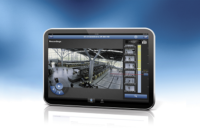
|
| Daniel Gundlach |
As part of the SDM State of the Market series, SDM has great conversations with industry professionals who offer tremendous insight. Sadly, we just don’t have the space to share all their information. This interview with Daniel Gundlach, vice president of marketing – North America, Bosch Security Systems Inc., Fairport, N.Y., is an extension of the comments that were used in this year’s article, “State of the Market: Video Surveillance.”
SDM: Looking ahead, how would you describe the “State of the Market” for video surveillance systems and services in 2014? What will make 2014 different from 2013?
Gundlach: The industry will continue to change in 2014 as we see new imaging advancements, even greater adoption of IP-based systems, more options for video management, and ever-shifting price points. 2014 will stand out in that we’ll see the first introduction of a 4K Ultra HD imaging device for security surveillance. 4K imaging delivers 8MP resolution that conforms to the SMPTE HD standard. The larger and richer video provides a tremendous advantage in detail capture with crisp, vivid images even when zoomed in digitally. This will make 4K imaging ideal for tracking people, capturing facial characteristics and numbers and for large area surveillance.
SDM: Which markets segments have been noticeably healthy customers of video surveillance? Among those customer segments, what is driving them to purchase video surveillance products, systems and services?
Gundlach: The retail, energy and utility, and transportation markets continue to offer the best growth opportunities. Increased security is the main driver among these organizations, and high resolution cameras give these customers the ability to identify people or vehicles more easily.
In addition, the ability for video surveillance streams to be integrated with other systems allows the technology to be used for other purposes as well. In retail, video can become another point of data for marketing or business intelligence. In industrial environments, surveillance equipment brings improvements to process monitoring. Video can be used as a verification tool for processes and for safety alerts or concerns. Intelligent devices can help users anticipate potential threats to safety.
SDM: Are there any technologies that are helping to boost video surveillance sales or changing the market in any way?
Gundlach: Advancements in bandwidth control have helped increase the proliferation of HD cameras. End users can now deploy high resolution cameras but control their bandwidth consumption through a number of ways. Dynamic Transcoding technology provides high resolution image playback within limited network connections. Intelligent Dynamic Noise Reduction analyzes the contents of a scene to reduce bandwidth and improve compression efficiency, thereby reducing storage costs. And, encoding regions allow uninteresting areas of a scene to be highly compressed while important areas are tuned for best image quality; this allows the user to allocate bandwidth to the most important parts of the scene.
High definition cameras are also becoming increasingly sensitive. Whereas in the past, low light areas and projects with other challenging lighting conditions required the use of standard definition cameras, new wide dynamic range and low light HD cameras are now delivering superior image quality and detail for these applications.
IP video is also more accessible for small- and medium-sized businesses that have traditionally relied on analog video for their security surveillance. For example, a small retail shop can get a very cost-effective system by combining IP cameras with local SD card storage and free viewing software, or by using a Dropbox application for remote storage of recorded activity along with a transcoder for mobile access to video. These options deliver a very affordable IP video system for small applications.
In addition, standards, such as ONVIF, have simplified product and system integration, making it easier for dealers to deliver the exact capabilities and image quality their customers require. The growing number of strategic partnerships between manufacturers is also making IP video products easier to integrate than ever before and is making more advanced camera features accessible via a range of security software offerings.
SDM: What technologies are you specifically choosing to focus on in 2014 and why?
Gundlach: We will continue to expand our HD video portfolio. We’ll introduce more cameras that deliver detailed images in challenging lighting and environmental conditions. We’ll deliver new options for panoramic video, and we’ll move the market forward with the introduction of the first 4K Ultra HD video surveillance camera. Our 4K solutions will transmit video at up to 30 frames per second for smooth motion – the highest performance available in the industry. They can also deliver 12MP resolution at an industry-leading 20 frames per second.
SDM: Is anything changing with end users requests or expectations when it comes to video?
Gundlach: The proliferation of mobile devices is making apps an integral part of surveillance—enabling video monitoring at any time and place. End users now expect to be able to view their surveillance video regardless of where they are. And, they expect high quality video on their mobile devices—even megapixel resolutions. New Dynamic Transcoding technology enables high resolution image playback within limited network connections. It synchronizes available bandwidth and image quality for viewing HD images with the best possible video quality, conducting fast forensic searches on recorded video, and for controlling PTZ cameras—immediately from anywhere.









